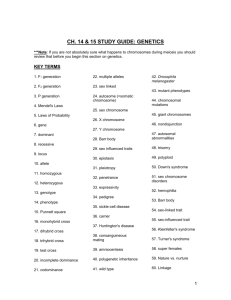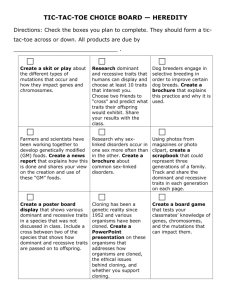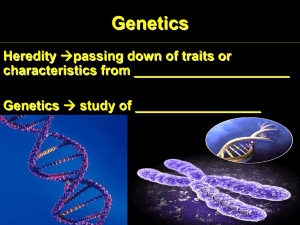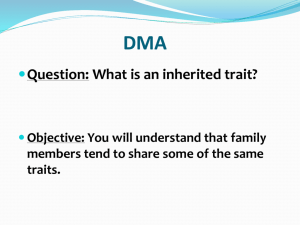AP Biology Genetics Study Guide Questions:
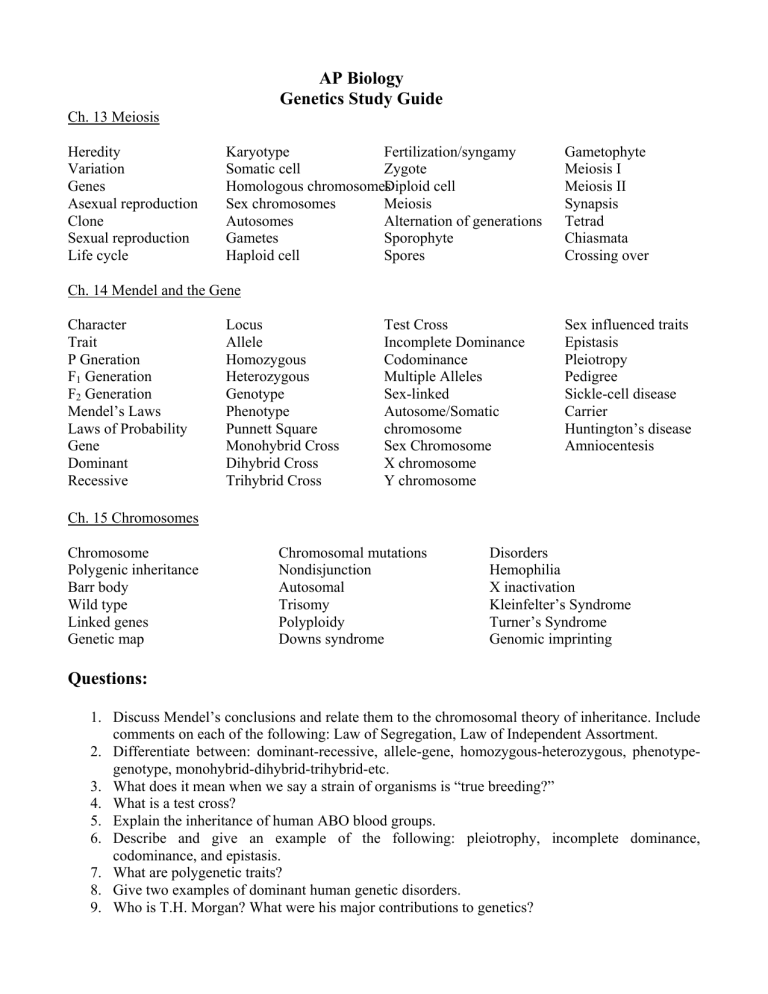
AP Biology
Genetics Study Guide
Ch. 13 Meiosis
Heredity
Variation
Genes
Asexual reproduction
Clone
Sexual reproduction
Life cycle
Karyotype
Somatic cell
Sex chromosomes
Autosomes
Gametes
Haploid cell
Ch. 14 Mendel and the Gene
Character Locus
Trait
P Gneration
F
1
Generation
F
2
Generation
Mendel’s Laws
Laws of Probability
Gene
Dominant
Recessive
Allele
Homozygous
Heterozygous
Genotype
Phenotype
Punnett Square
Monohybrid Cross
Dihybrid Cross
Trihybrid Cross
Fertilization/syngamy
Zygote
Meiosis
Alternation of generations
Sporophyte
Spores
Test Cross
Incomplete Dominance
Codominance
Multiple Alleles
Sex-linked
Autosome/Somatic chromosome
Sex Chromosome
X chromosome
Y chromosome
Ch. 15 Chromosomes
Chromosome
Polygenic inheritance
Barr body
Wild type
Linked genes
Genetic map
Chromosomal mutations
Nondisjunction
Autosomal
Trisomy
Polyploidy
Downs syndrome
Gametophyte
Meiosis I
Meiosis II
Synapsis
Tetrad
Chiasmata
Crossing over
Sex influenced traits
Epistasis
Pleiotropy
Pedigree
Sickle-cell disease
Carrier
Huntington’s disease
Amniocentesis
Disorders
Hemophilia
X inactivation
Kleinfelter’s Syndrome
Turner’s Syndrome
Genomic imprinting
Questions:
1.
Discuss Mendel’s conclusions and relate them to the chromosomal theory of inheritance. Include comments on each of the following: Law of Segregation, Law of Independent Assortment.
2.
Differentiate between: dominant-recessive, allele-gene, homozygous-heterozygous, phenotypegenotype, monohybrid-dihybrid-trihybrid-etc.
3.
What does it mean when we say a strain of organisms is “true breeding?”
4.
What is a test cross?
5.
Explain the inheritance of human ABO blood groups.
6.
Describe and give an example of the following: pleiotrophy, incomplete dominance, codominance, and epistasis.
7.
What are polygenetic traits?
8.
Give two examples of dominant human genetic disorders.
9.
Who is T.H. Morgan? What were his major contributions to genetics?
10.
What does it mean if we say genes are linked? Which of Mendel’s “laws” do linked genes violate?
11.
Explain linkage and show how crossover frequencies are used to make chromosome maps.
12.
What kind of information is shown on chromosome maps/
13.
Describe how each of the following chromosomal alterations changes the structure of chromosomes: deletion, duplication, inversion, and translocation.
14.
Explain how sex is determined in humans.
15.
Describe how the X-Y, W-Z, and haplo-diploidy systems of sex determination and give examples of each.
16.
Discuss sex-linked inheritance in terms of X and Y chromosomes.
17.
Explain gene dosage in terms of human female X chromosomes. Include in your description an explanation of what Barr bodies are.
18.
What is aneuplody (think about roots and prefixes-au, eu, and ploidy)? Describe triploidy and polyploidy.
19.
Explain nondisjunction and tell how it affects chromosomal composition of cells.
20.
Discuss chromosomal aberrations, including changes in individual chromosomes and alterations in chromosome number. Include in your discussion causes of these aberrations.
21.
Explain how translocations, deletions, duplications, and inversions alter chromosomal composition.
22.
Describe the cause of Down syndrome.
23.
Give five examples of human genetic diseases.
24.
Distinguish between Turner’s, Kleinfelter’s, and Trisomy X syndromes.
25.
Explain why statistics is a useful (or scientific) tool.
26.
Explain why a large sample is more statistically reliable than a small sample?
27.
Why is Drosophilia such a good organism in which to study genetics?
A Method For Doing Mendelian Crosses
1.
Know the traits to be used.
2.
Know how the alleles are expressed. Which is dominant, which is recessive, and which is incomplete.
3.
Establish a letter symbol for each trait. Use capital letters for dominant traits and small letters for the recessive allele.
4.
Determine the genotypes of the parents. Keep in mind which traits are dominant and which are recessive when you do this.
5.
Determine the gametes which are produced by the parents.
6.
Combine the gametes. A Punnett square can be used.
7.
Determine the genotype and phenotype ratios of the offspring.
Tips For Solving Genetic Problems
1.
Only homozygous recessive genotypes express the recessive trait.
2.
If an individual expresses a dominant trait that individual has AT LEAST one dominant gene.
3.
If an indeterminate condition or blending of traits is observed expect codominance.
4.
If a trait expresses itself mainly in males, suspect sex-linkage.
5.
Monohybrid heterozygous crosses result in 3:1 phenotype ratios.
6.
Dihybrid heterozygous crosses result in 9:3:3:1 phenotype ratios.





